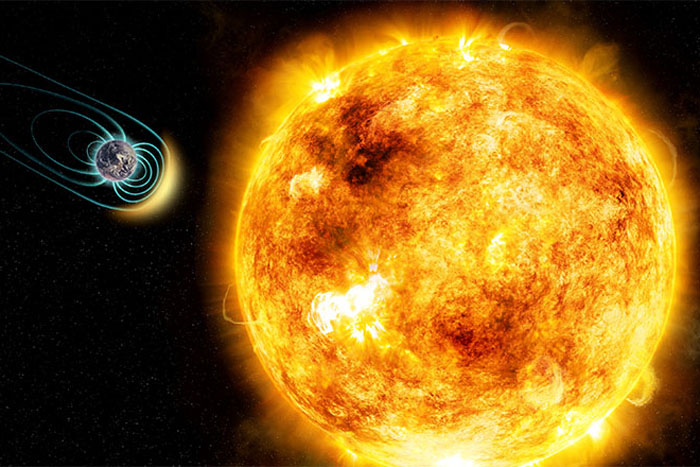Earth's Magnetism Saved It From Solar Sterilization

When our sun was young, it was a very nasty star that erupted with "superflares" and blowtorched the inner solar system with powerful solar winds. Fortunately, the sun finally grew up and mellowed, reaching the calm(er) state it is now.
For early life on Earth, our planet's magnetosphere likely provided much-needed protection against the stellar onslaught, facilitating the evolution of our thriving biosphere. And through the study of a nearby young sun-like star called Kappa Ceti, we now know how lucky we are to have such an effective global magnetic field.
PHOTOS: Epic Auroras Throughout the Solar System
Kappa Ceti is located only 30 light-years away in the constellation Cetus and astronomers estimate that it is 400-600 million years old.
This star may be sun-like, but it has a lot of growing up to do. At this early stage in its life cycle it is a tumultuous mess, erupting with powerful magnetic activity. Like a teenager going through adolescence, its uppermost layers are erupting with huge clusters of starspots, revealing the violent energy that is torturing its stellar interior.
The result is a star that is very, very angry, exploding with flares that release 10-100 million times more energy than the most powerful solar flare ever observed on our sun. In addition, Kappa Ceti’s stellar winds are 50 times more powerful than our sun’s solar wind, ripping through nearby space like a relentless plasma hurricane.
ANALYSIS: Visualizing Our Sun's Messy Magnetic Mystery
Get the Space.com Newsletter
Breaking space news, the latest updates on rocket launches, skywatching events and more!
We are in effect looking back in time at a star that would have resembled our sun billions of years ago. But to look at this star from afar, it would seem like an impossibility that any biology would survive on a hypothetical planet in orbit. And yet Earth's biosphere braved the storm of our sun's youth, a hint that it's not good enough to have a planet orbiting a star within a star's habitable zone; that planet needs its own magnetic shield.
"To be habitable, a planet needs warmth, water, and it needs to be sheltered from a young, violent sun," said Jose-Dias Do Nascimento of the Harvard-Smithsonian Center for Astrophysics (CfA) and University of Rio G. do Norte (UFRN), Brazil, and lead author of a study to be published in The Astrophysical Journal Letters.
Though it's taken billions of years for the Earth's magnetosphere to grow to the strength it is now, some estimates suggest that it was half as strong when the sun was at its most ferocious. But it was, apparently, enough. Around 4 billion years ago, basic life appeared on Earth and now we have an intelligent civilization thriving inside a rich and diverse biosphere. Earth's magnetosphere did its job.
ANALYSIS: Violent Tiny Star Is a Magnetic Powerhouse
The Earth's magnetosphere acts as an invisible shield, buffering the sun's constant stream of energetic solar plasma. Solar storms do occur and often result in stunning auroral displays as these high-energy particles are magnetically diverted and rain down through the atmosphere at high latitudes. For the most part, life is safe from this ionizing radiation and the magnetosphere also prevents our dense atmosphere from being eroded away by the solar wind.
Alas, there is one example in the solar system that is the "poster child" of solar abuse. Mars either lost its global magnetic field early in its history or it never really held onto a sufficiently strong magnetosphere. It succumbed to the constant erosion of the solar wind and countless solar storms and we now know that its atmosphere is constantly bleeding into space. Its frigid atmosphere is 100th the pressure of Earth's, so it was never given the chance to nurture complex life forms — as to whether it even supported the most basic microbial life remains to be seen.
So the next time you feel the sun's heat on your skin, remember that it was our Earth's global magnetic field that allowed life to gain a foothold, ultimately creating sentient life shielded from the worst our young sun could throw at it.
Source: CfA
Join our Space Forums to keep talking space on the latest missions, night sky and more! And if you have a news tip, correction or comment, let us know at: community@space.com.
Ian O'Neill is a media relations specialist at NASA's Jet Propulsion Laboratory (JPL) in Southern California. Prior to joining JPL, he served as editor for the Astronomical Society of the Pacific‘s Mercury magazine and Mercury Online and contributed articles to a number of other publications, including Space.com, Space.com, Live Science, HISTORY.com, Scientific American. Ian holds a Ph.D in solar physics and a master's degree in planetary and space physics.









